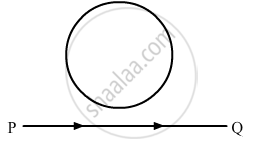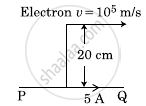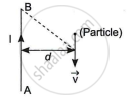Advertisements
Advertisements
प्रश्न
Define magnetic lines of force
उत्तर
The path along which a unit the North Pole moves in a magnetic field is called a magnetic line of force.
APPEARS IN
संबंधित प्रश्न
A conducting loop is held above a current carrying wire PQ as shown in the figure. Depict the direction of the current induced in the loop when the current in the wire PQ is constantly increasing.

Magnetic lines of force always cross each other
A steady current (I1) flows through a long straight wire. Another wire carrying steady current (I2) in the same direction is kept close and parallel to the first wire. Show with the help of a diagram how the magnetic field due to the current I1 exerts a magnetic force on the second wire. Write the expression for this force.
Choose the correct alternative and rewrite the following:
What will happen to the current passing through a resistance, if the potential difference across it is doubled and the resistance is halved?
An electron is moving with a speed of 3.2 × 107 m/s in a magnetic field of 6.00 × 10-4 T perpendicular to its path. What will be the radium of the path? What will be frequency and the energy in keV?
[Given: mass of electron = 9.1 × 10−31 kg, charge e = 1.6 × 10−19 C, 1 eV = 1.6 × 10−19 J]
A magnetic field set up using Helmholtz coils is uniform in a small region and has a magnitude of 0.75 T. In the same region, a uniform electrostatic field is maintained in a direction normal to the common axis of the coils. A narrow beam of (single species) charged particles all accelerated through 15 kV enters this region in a direction perpendicular to both the axis of the coils and the electrostatic field. If the beam remains undeflected when the electrostatic field is 9.0 × 10–5 V m–1, make a simple guess as to what the beam contains. Why is the answer not unique?
In SI system, permeability has the units ______.
- perpendicular to direction of velocity of charged particle.
-
perpendicular to direction of magnetic field.
-
parallel to direction of velocity of charged particle.
-
parallel to the direction of magnetic field.
Which one of the following is a correct statement about magnetic forces?
An infinitely long straight conductor carries a current of 5 A as shown. An electron is moving with a speed of 105 m/s parallel to the conductor. The perpendicular distance between the electron and the conductor is 20 cm at an instant. Calculate the magnitude of the force experienced by the electron at that instant.

A charged particle would continue to move with a constant velocity in a region wherein ______.
- E = 0, B ≠ 0.
- E ≠ 0, B ≠ 0.
- E ≠ 0, B = 0.
- E = 0, B = 0.
An electron enters with a velocity v = v0i into a cubical region (faces parallel to coordinate planes) in which there are uniform electric and magnetic fields. The orbit of the electron is found to spiral down inside the cube in plane parallel to the x-y plane. Suggest a configuration of fields E and B that can lead to it.
A unit vector is represented as `(0.8hat"i" + "b"hat"j" + 0.4hat"k")`. Hence the value of 'b' must be ______.
A long straight wire AB carries a current I. A particle (mass m and charge q) moves with a velocity `vec"v"`, parallel to the wire, at a distance d from it as shown in the figure. Obtain the expression for the force experienced by the particle and mention its directions.

A long straight conductor kept along X' X axis, carries a steady current I along the +x direction. At an instant t, a particle of mass m and charge q at point (x, y) moves with a velocity `vecv` along +y direction. Find the magnitude and direction of the force on the particle due to the conductor.
An electron is moving along positive x-axis in a magnetic field which is parallel to the positive y-axis. In what direction will the magnetic force be acting on the electron?
With a neat labelled diagram, explain cyclotron motion and cyclotron formula.
State dimensions of magnetic field.
